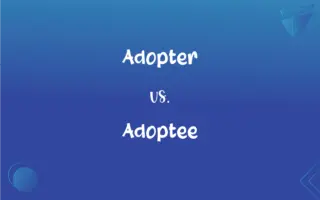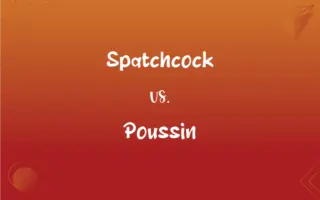Partridge vs. Grouse: What's the Difference?
By Aimie Carlson & Harlon Moss || Updated on March 4, 2024
Partridges are medium-sized, non-migratory birds of the pheasant family, often found in grasslands. Grouse are larger, forest or tundra-dwelling birds within the same family, adapted to a variety of habitats.

Key Differences
Partridges, characterized by their smaller size and preference for open habitats like farmlands and grasslands, are ground-nesting birds that primarily feed on seeds, leaves, and small insects. They are often found in warmer climates and are known for their ground-nesting habits and inability to migrate long distances. Grouse, on the other hand, are adapted to colder climates and can be found in forested areas as well as arctic tundras. They have a more robust body and are larger than partridges, with some species developing feathered feet that act as snowshoes during winter.
Partridges are more likely to be found in agricultural lands or open fields, where they can blend into their surroundings to avoid predators. Grouse are known for their complex mating rituals, including lekking, where males display elaborate dances and sounds to attract females. Their diet is more varied, including buds, leaves, berries, and insects, depending on the season and available resources.
While both partridges and grouse are part of the Phasianidae family, their adaptations to different environments highlight their ecological diversity. Partridges have a more limited range, often restricted by their habitat preferences and lower mobility. In contrast, grouse species have a wider distribution due to their ability to inhabit diverse terrains, from dense forests to open tundra landscapes.
The social behavior of these birds also differs. Partridges are more likely to be seen in pairs or small family groups, especially during the breeding season. Grouse, especially outside the mating season, can form larger flocks known as coveys, which offer protection against predators.
Conservation efforts for both groups vary depending on their habitat and the specific threats they face. While some partridge species have declined due to habitat loss and hunting, grouse species are often threatened by deforestation, climate change, and in some areas, overhunting.
ADVERTISEMENT
Comparison Chart
Size
Smaller
Larger
Habitat
Grasslands, farmlands
Forests, tundras
Diet
Seeds, leaves, small insects
Buds, leaves, berries, insects
Behavior
Ground-nesting, less social
Complex mating displays, more social in flocks
Adaptations
Prefer warmer climates, ground-nesting
Feathered feet in some species, adapted to cold
ADVERTISEMENT
Distribution
More limited, warmer areas
Wider, diverse terrains
Conservation
Threatened by habitat loss, hunting
Affected by deforestation, climate change
Mating Rituals
Less elaborate
Known for elaborate dances and sounds (lekking)
Partridge and Grouse Definitions
Partridge
A medium-sized bird often found in open habitats.
The grey partridge is commonly seen in European farmlands.
Grouse
A larger bird adapted to forested or tundra habitats.
The sage grouse inhabits sagebrush ecosystems in the Western United States.
Partridge
Prefers seeds and small insects.
Partridges forage for seeds and insects in the early morning.
Grouse
Diet varies seasonally.
Grouse eat berries in the fall and buds in the winter.
Partridge
Known for ground-nesting behavior.
Partridges lay their eggs on the ground, hidden among the crops.
Grouse
Forms larger flocks known as coveys.
Grouse gather in large flocks for protection during winter.
Partridge
Any of various plump-bodied game birds of several genera in the family Phasianidae, native to Eurasia and Africa and introduced elsewhere.
Grouse
Exhibits complex mating displays.
Male grouse perform distinctive dances and sounds to attract females.
Partridge
Any of several game birds, such as the ruffed grouse or the bobwhite, similar to a partridge.
Grouse
Any of various plump, chiefly ground-dwelling gallinaceous birds of the subfamily Tetraoninae of northern North America and Eurasia, characteristically having feathered legs and nostrils and mottled plumage.
Partridge
(ornithology) Any bird of a number of genera in the family Phasianidae, notably in the genera Perdix and Alectoris.
On the first day of Christmas, my true love sent to me a partridge in a pear tree.
Grouse
A cause for complaint.
Partridge
A type of cannon charge composed of several missiles fired all together, similar to langrage or case-shot. Also a large cannon that shoots stones.
Grouse
To complain; grumble.
Partridge
Any one of numerous species of small gallinaceous birds of the genus Perdix and several related genera of the family Perdicidæ, of the Old World. The partridge is noted as a game bird.
Full many a fat partrich had he in mew.
Grouse
(countable) Any of various game birds of the subfamily Tetraoninae which inhabit temperate and subarctic regions of the Northern Hemisphere; specifically, the red grouse (Lagopus lagopus scotica) native to heather moorland on the British Isles.
Partridge
Any one of several species of quail-like birds belonging to Colinus, and allied genera.
Grouse
(uncountable) The flesh or meat of this bird eaten as food.
Partridge
The ruffed grouse (Bonasa umbellus).
Grouse
(informal) A cause for complaint; a grumble.
Partridge
Flesh of either quail or grouse
Grouse
(intransitive) To hunt or shoot grouse.
Partridge
Heavy-bodied small-winged South American game bird resembling a gallinaceous bird but related to the ratite birds
Grouse
To complain or grumble.
Partridge
Small Old World gallinaceous game birds
Grouse
Excellent.
I had a grouse day.
That food was grouse.
Partridge
A popular North American game bird; named for its call
Grouse
Any of the numerous species of gallinaceous birds of the family Tetraonidæ, and subfamily Tetraoninæ, inhabiting Europe, Asia, and North America. They have plump bodies, strong, well-feathered legs, and usually mottled plumage. The group includes the ptarmigans (Lagopus), having feathered feet.
Partridge
Valued as a game bird in eastern United States and Canada
Grouse
To seek or shoot grouse.
Partridge
Less social outside breeding season.
Partridges are often seen alone or in pairs after the breeding season.
Grouse
To complain or grumble; as, employees grousing about their incompetent boss.
Partridge
Adapted to warmer climates.
Partridges thrive in temperate regions without needing to migrate.
Grouse
Flesh of any of various grouse of the family Tetraonidae; usually roasted; flesh too dry to broil
Grouse
Popular game bird having a plump body and feathered legs and feet
Grouse
Hunt grouse
Grouse
Complain;
What was he hollering about?
Grouse
Some species have feathered feet.
The willow grouse has feathered feet that act as snowshoes.
FAQs
Can grouse and partridges be found in the same habitat?
While both can be found in temperate regions, their specific habitat preferences (open fields for partridges, forests, and tundras for grouse) generally keep them apart.
What distinguishes a partridge from a grouse?
Partridges are smaller, prefer open habitats, and are less social, while grouse are larger, inhabit forests or tundras, and have complex mating displays.
Are partridges capable of long-distance migration?
Most partridge species do not migrate long distances, preferring to remain within their habitat range throughout the year.
Why are grouse's mating rituals considered elaborate?
Grouse perform intricate dances, vocalizations, and sometimes display vibrant plumage to attract mates, a behavior known as lekking.
What conservation issues affect partridges and grouse?
Habitat loss and degradation impact both, but specific issues like deforestation for grouse and agricultural practices for partridges pose significant threats.
How do partridges and grouse adapt to winter conditions?
Grouse, especially those in colder climates, may develop feathered feet to navigate snow, whereas partridges rely on their habitat's milder conditions.
What role does social behavior play in the survival of grouse and partridges?
Social behaviors, including flocking in grouse, offer protection against predators, while partridges' more solitary behavior helps them blend into their surroundings.
Can both grouse and partridges be hunted?
Yes, both are hunted for sport and food, but regulations and conservation efforts aim to ensure sustainable populations.
What efforts are being made to conserve partridges and grouse?
Conservation efforts include habitat restoration, hunting regulations, and research into their breeding and feeding habits to support population recovery.
Do partridges and grouse have any natural predators?
Yes, both are preyed upon by a variety of predators including foxes, hawks, and owls. Their respective camouflage and flocking behaviors help protect them from these threats.
How do human activities impact the habitats of partridges and grouse?
Human activities such as deforestation, agricultural expansion, and urbanization can degrade and fragment the natural habitats of both birds, leading to population declines.
Can grouse and partridges be kept as pets?
While it's uncommon, some people may keep them as part of game bird collections or for hunting purposes. However, they require specific care and habitats to thrive in captivity.
What are the biggest challenges in conserving partridges and grouse?
The biggest challenges include habitat loss, climate change, and hunting pressures. Addressing these issues requires comprehensive habitat conservation strategies and effective wildlife management policies.
How do diet preferences differ between partridges and grouse?
Partridges primarily consume seeds and insects, while grouse have a more varied diet that changes seasonally, including berries, leaves, and buds.
What is the significance of the feathered feet in some grouse species?
Feathered feet in grouse act as natural snowshoes, helping them walk on top of snow without sinking, which is crucial for survival in their cold, snowy habitats.
Are there any successful conservation stories for partridges or grouse?
There are conservation efforts that have successfully stabilized or increased certain grouse and partridge populations through habitat management, legal protection, and breeding programs.
How does the breeding season behavior of partridges and grouse differ?
During breeding season, partridges may form pairs or small groups, while grouse often participate in lekking, where males gather and compete for female attention through displays.
How do the nesting habits of partridges and grouse differ?
Partridges nest on the ground in simple scrapes lined with plant material, often in open areas, while grouse may use denser vegetation or even snow in forested or tundra regions to conceal their nests.
What role do partridges and grouse play in their ecosystems?
As part of the food web, they serve as prey for predators and also act as seed dispersers, contributing to the health and diversity of their ecosystems.
How do climate changes affect grouse and partridges?
Climate change can alter their habitats, food availability, and migration patterns, potentially leading to stress and decline in populations.
About Author
Written by
Aimie CarlsonAimie Carlson, holding a master's degree in English literature, is a fervent English language enthusiast. She lends her writing talents to Difference Wiki, a prominent website that specializes in comparisons, offering readers insightful analyses that both captivate and inform.
Co-written by
Harlon MossHarlon is a seasoned quality moderator and accomplished content writer for Difference Wiki. An alumnus of the prestigious University of California, he earned his degree in Computer Science. Leveraging his academic background, Harlon brings a meticulous and informed perspective to his work, ensuring content accuracy and excellence.































































